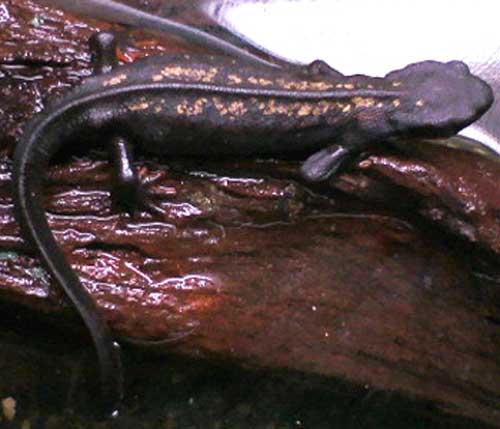
Cynops ensicauda (*)
Superregnum: Eukaryota
Cladus: Unikonta
Cladus: Opisthokonta
Cladus: Holozoa
Regnum: Animalia
Subregnum: Eumetazoa
Cladus: Bilateria
Cladus: Nephrozoa
Superphylum: Deuterostomia
Phylum: Chordata
Subphylum: Vertebrata
Infraphylum: Gnathostomata
Megaclassis: Osteichthyes
Cladus: Sarcopterygii
Cladus: Rhipidistia
Cladus: Tetrapodomorpha
Cladus: Eotetrapodiformes
Cladus: Elpistostegalia
Superclassis: Tetrapoda
Classis: Amphibia
Subclassis: Lissamphibia
Ordo: Urodela
Subordo: Salamandroidea
Familia: Salamandridae
Subfamilia: Pleurodelinae
Genus: Cynops
Species: Cynops ensicauda
Subspecies: C. e. ensicauda - C. e. popei
Name
Cynops ensicauda (Hallowell, 1861)
Type locality: "Paddyfields at the Amakarima Isle" and "Ralousima... the northern half of Ousima proper" (= Amami, Ryukyu Is., Japan).
Syntypes: USNM 7410 (3 specimens).
Synonyms
Triton ensicauda Hallowell, 1861
Molge pyrrhogaster var. ensicauda — Boulenger, 1887
Molge pyrrhogastra var. ensicaudatus — Okada, 1891
Molge pyrrhogaster ensicauda — Brown, 1902
Diemictylus ensicauda — Stejneger, 1907
Triturus ensicaudus — Dunn, 1918
Triton pyrrhogaster subsp. ensicauda — Wolterstorff, 1925
Triton (Cynops) pyrrhogaster — Wolterstorff, 1927
Cynops ensicauda — Wolterstorff & Herre, 1935
Triturus ensicauda — Sato, 1943
Triturus ensicaudus popei Inger, 1947
Triturus ensicaudus ensicaudus — Inger, 1947
Triturus pyrrhogaster ensicaudus — Kawamura, 1950
Triturus (Cynops) pyrrhogaster ensicaudus — Nakamura & Ueno, 1963
Cynops pyrrhogaster popei — Brame, 1967
Cynops ensicauda ensicauda — Thorn, 1968
References
Hallowell, E., 1860. Proc. Acad. Nat. Sci. Philadelphia 12: 494.
Thorn, 1968, Salamand. Eur. Asie Afr. Nord: 281.
Frost, D. 2008. Amphibian Species of the World: an Online Reference. Version 5.2 (15 July, 2008). Electronic Database accessible at www.research.amnh.org/herpetology/amphibia. American Museum of Natural History, New York, USA. Cynops ensicauda
AmphibiaWeb: Information on amphibian biology and conservation. [web application]. 2010. Berkeley, California: Cynops ensicauda. AmphibiaWeb, available at http://amphibiaweb.org/.
2007 IUCN Red List of Threatened Species IUCN: Cynops ensicauda (Endangered) Downloaded on 7 August 2008.
Environment Agency of Japan (eds.), 2000. Threatened Wildlife of Japan -Red Data Book 2nd ed.- Reptillia/Amphibia. ISBN4-915959-70-8. [1]
Vernacular names
English: Japanese Sword-tail Newt
suomi: Miekkahäntätulilisko
日本語: シリケンイモリ
The sword-tail newt (Cynops ensicauda) is a species of true salamander from the Ryukyu Archipelago in Japan. It has recently been placed on Japan's Red List of Threatened Amphibians. Sword-tail newts are poisonous, and may also be referred to as fire-bellied newts due to the orange coloration of their underside. They are not to be confused with the common Chinese and Japanese species. It is distinguished from these two species by their larger size, broader heads and smoother skin. Its coloration ranges from brown to black, occasionally with an orange dorsal stripe. Some individuals may have light spotting or speckling on their backs.
Sword-tailed newts can reach 12.8 cm (5.0 in) in males and 18 cm (7.1 in) in females.[3] They are the largest living members of their genus.[3] They exhibit sexual dimorphism. Females’ tails are longer than the rest of their body; those of males are much shorter, and sometimes display a whitish sheen during breeding season.
Habitat and distribution
The sword-tailed newt is only found on the Ryukyu Archipelago, an island chain off the southern coast of Japan, as well as on many smaller surrounding islands. The newts typically live in cool, stagnant bodies of water. They are commonly found in man-made structures such as rice paddies, road-side ditches, and cattle waterholes.[3] The two known subspecies of sword-tailed newt are C. e. ensicauda and C. e. popei. Due to the subtropical climate of its native habitat, it is more tolerant of high temperatures than other Cynops. The sword-tailed newt has no natural predators,[citation needed] thus deforestation and land development are the main causes of their endangerment.
As of 2010, breeding grounds were visited by 75% less newts than in 1996.[citation needed] Many of their breeding sites are in roadside ditches and gutters, and they are highly territorial, making it difficult to relocate them.
Trends and threats
The populations of C. ensicauda have declined in recent years, especially as a result of habitat destruction due to land development. Large predatory fish of the genus Tilapia have been introduced into traditional breeding ponds. Even in locations where suitable forest habitat has been preserved, the construction of access roads with concrete drainage ditches kills many; the newts wander to forage on rainy days and may fall into the ditches, where they will die when the rain ceases (Goris and Maeda 2004).[4]
References
IUCN SSC Amphibian Specialist Group (2021). "Cynops ensicauda". IUCN Red List of Threatened Species. 2021: e.T59441A177225544. doi:10.2305/IUCN.UK.2021-1.RLTS.T59441A177225544.en. Retrieved 20 November 2021.
"Cynops ensicauda". Amphibian Species of the World 5.5. American Museum of Natural History. Retrieved 8 September 2012.
Caudata Culture Species Entry - Cynops ensicauda
"AmphibiaWeb - Cynops ensicauda". amphibiaweb.org. Retrieved 2017-03-03.
Retrieved from "http://en.wikipedia.org/"
All text is available under the terms of the GNU Free Documentation License

